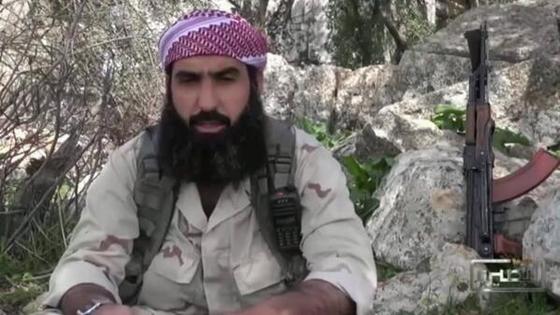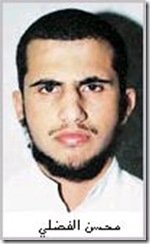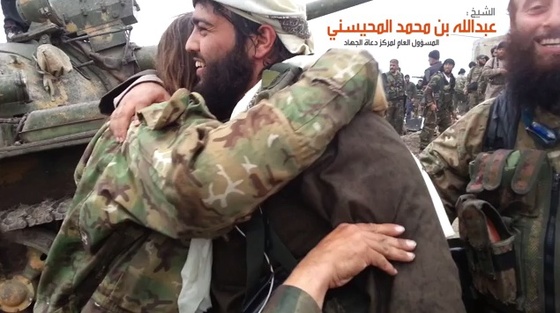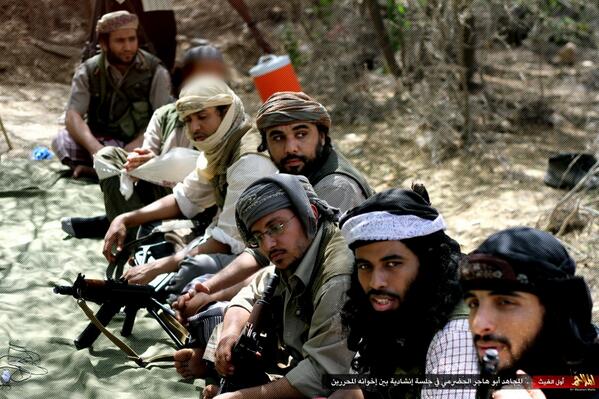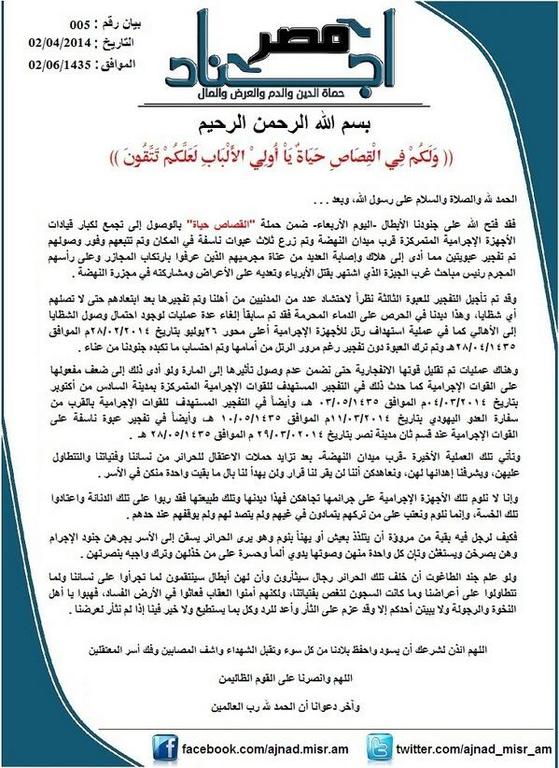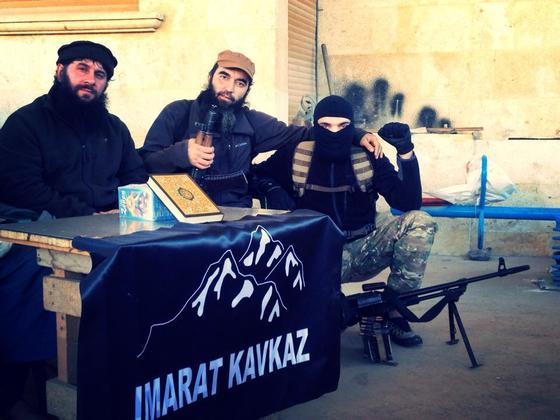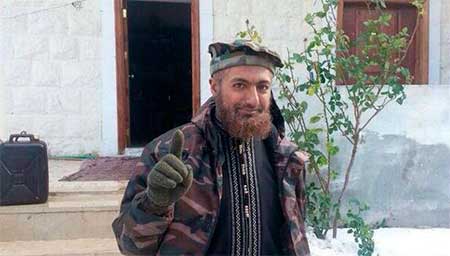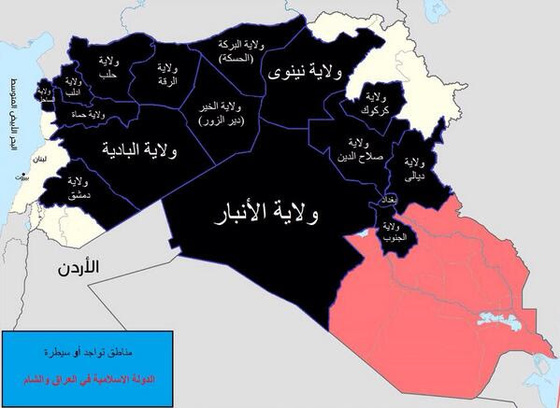![Salahuddin-al-Shishani.jpeg]()
|
| Salahuddin al Shishani (left), a Chechen commander who leads the Jaish al Muhajireen wal Ansar, and Abdul Karim al Ukrani (center), a Ukrainian, sitting behind an Imarat Kavkaz flag while in Syria. |
Editor's note: Below is Bill Roggio's testimony to the House Committee on Homeland Security's Subcommittee on Counterterrorism and Intelligence on the threat posed by the Islamic Caucasus Emirate and the implications for US homeland security. If you wish to view the testimony with footnotes included, download the PDF by clicking here.
Chairman King, Ranking Member Higgins, members of the committee, thank you for inviting me here to discuss the terrorist threat emanating from the Caucasus. Unfortunately, as we saw nearly one year ago today at the Boston Marathon, the jihad in the Caucasus has already impacted lives here in the US.
There is still much we do not know for certain about Tamerlan Tsarnaev's travels in Dagestan and Chechnya, but we do know that, at a minimum, he was sympathetic to the jihadists operating there. Tamerlan Tsarnaev and his younger brother were, of course, responsible for the attacks on the Boston Marathon. As a report by the House Homeland Security Committee noted just last month, it "is reasonable to assume that Tamerlan Tsarnaev was at least inspired by" the "activity and ideology" of jihadists fighting in the Caucasus and he was "driven to take part in the vision of global jihad which they share with al Qaeda." Indeed, the Imarat Kavkaz or "IK" (otherwise known as the Islamic Caucasus Emirate) does have links to al Qaeda. And Tsarnaev is known to have sympathized with the IK and its fighters.
The IK has openly proclaimed itself a threat to the US and the West, and we should take these threats seriously. The US State Department certainly does. In May 2011, the State Department officially designated the IK as a terrorist organization. "The designation of Caucasus Emirate is in response to the threats posed to the United States and Russia," Ambassador Daniel Benjamin, the State Department's Coordinator for Counterterrorism, said at the time. "The attacks perpetrated by Caucasus Emirate illustrate the global nature of the terrorist problem we face today," Benjamin added. In June 2010, the State Department added Doku Umarov, who was then the emir of the IK, to the US government's list of Specially Designated Global Terrorists. And in May 2011, Foggy Bottom offered a reward of $5 million for information leading to Umarov's location. In both its June 2010 and May 2011 announcements, the State Department noted that Umarov and the IK pose a threat to the US and other countries. Indeed, Umarov described the IK as "a part of the global Jihad" in a July 2013 statement in which he called for further attacks aimed at disrupting Russia's plans for the 2014 Winter Olympic Games in Sochi.
Despite the fact that Umarov was recently killed, there are good reasons to suspect that the IK will continue to pose a threat to American and Western interests both in and outside of Russia. As with other al Qaeda-affiliated groups, the IK will continue to spend most of its resources waging insurgencies, both inside Russia and elsewhere. Still, in my testimony today, I will highlight several key reasons why the IK poses a terrorist threat to the West. Those reasons are:
Osama bin Laden and al Qaeda helped transform the insurgency in Chechnya from a nationalist one into part of the global jihad. Al Qaeda's senior leadership established its influence within the Caucasus long ago. While al Qaeda was headquartered in Sudan from 1991 to 1996, Osama bin Laden maintained a network of training camps and other facilities that shuttled fighters to several jihadist fronts, including Chechnya. During the 1990s al Qaeda and the Egyptian Islamic Jihad (EIJ) funneled cash and other support to Muslim rebels in Chechnya through a charity in Baku, Azerbaijan. Ayman al Zawahiri himself, then the head of the EIJ, as well as second in command of al Qaeda, set out for Chechnya in late 1996. He was accompanied by other dual-hatted al Qaeda-EIJ operatives. Zawahiri was arrested in Dagestan before he reached Chechnya and spent several months in prison. Zawahiri's trip to the region underscores, from al Qaeda's perspective, the importance of supporting the jihad in Chechnya.
Al Qaeda's efforts in Chechnya have clearly borne fruit. Two highly influential jihadists in Chechnya became closely allied with al Qaeda's senior leaders. Shamil Salmanovich Basayev (a Chechen) and Ibn al Khattab (a Saudi) established the Islamic International Brigade (IIB). "In October 1999," according to the United Nations Security Council committee responsible for sanctioning al Qaeda and Taliban affiliated groups, "emissaries of Basayev and al Khattab traveled to Osama bin Laden's home base in the Afghan province of Kandahar, where Bin Laden agreed to provide substantial military assistance and financial aid, including by making arrangements to send to Chechnya several hundred fighters to fight against Russian troops and perpetrate acts of terrorism." Also in 1999, bin Laden "sent substantial amounts of money to" Basayev, al Khattab and other jihadists in Chechnya. The money "was to be used exclusively for training gunmen, recruiting mercenaries and buying ammunition." By the end of 2002, IIB leaders "had received several million dollars from international terrorist organizations, including al Qaeda." Al Qaeda continued to raise funds for the IIB after the 9/11 attacks.
By 1995, the UN notes, "Arab Afghans" - that is, men from throughout the Arab world who traveled to fight the Soviets in Afghanistan during the 1980s - accounted for a "substantial" number "of those fighting against Russian troops." Al Qaeda not only supported the jihad inside Chechnya, but also made sure to integrate Chechens into its operations in Afghanistan. Al Qaeda's elite "055 Brigade," which fought alongside the Taliban against the Northern Alliance, "included a number of Chechens, many of whom were believed to be followers of" IIB leaders. In October 2001, al Khattab supported al Qaeda's fight against coalition forces by sending "additional fighters to Afghanistan" and promising "to pay the volunteers' families a substantial monthly stipend or a large lump-sum payment in the event of their death."
Fighters from the Caucasus are present in the Afghanistan-Pakistan region to this day. The International Security Assistance Force (ISAF) has identified "Chechen" fighters in Afghanistan as recently as May 2011, when it noted that a foreign fighter network in Kunduz "facilitates foreign suicide bombers including Chechens and Pakistanis throughout the province." A group calling itself the Caucasus Mujahideen in Khorasan announced its presence in October 2011, saying it was in direct contact with its "brothers" in Russia. The UN has noted that Umarov, the deceased head of the IK, supported both the Islamic Jihad Group and the Islamic Movement of Uzbekistan (IMU). Both groups are based in South Asia and closely allied with al Qaeda.
Al Qaeda has repeatedly highlighted the fighting in Chechnya in its propaganda videos. After the USS Cole bombing in October 2000, Osama bin Laden ordered his media committee to produce a propaganda video that included a reenactment of the Cole bombing, as well as footage from Chechnya and other jihadist hotspots. The plight of Muslims in Chechnya remained a theme in al Qaeda's messaging in the years that followed. And al Qaeda continues to present the fighting in Chechnya as part of its global jihad. In January of this year, Ayman al Zawahiri praised Chechen fighters, saying that the "fighting for Chechnya is another page of the pages of eternal jihad to as to achieve true justice in the name of Allah." Zawahiri asked if other jihadists would be willing to follow the Chechens' example: "Are we, as Muslims, ready to take the path of the Chechens, and enroll in the ranks of the fight in the name of Allah?" Zawahiri called on Muslims in Egypt, Libya and Tunisia to follow the Chechens' lead in rejecting democracy and waging jihad.
The jihad in Chechnya has been used to recruit terrorists - including a number of the 9/11 hijackers - who were repurposed for attacks against American interests. As the 9/11 Commission reported, al Qaeda's Hamburg cell traveled "to Afghanistan aspiring to wage jihad in Chechnya," but al Qaeda "quickly recognized their potential and enlisted them in its anti-U.S. jihad." The Hamburg cell included the terrorists who flew the hijacked planes on 9/11. Some of the muscle hijackers from Saudi Arabia initially wanted to fight in Chechnya. Khalid Sheikh Mohammed (KSM), the mastermind of 9/11, also attempted to join the ranks of the main jihadist leader in Chechnya, Ibn al Khattab. And in August 2001, French authorities provided evidence to the US government that Zacarias Moussaoui, who was slated to take part in a follow-on attack after 9/11, had his own ties to Khattab.
The IK has adopted al Qaeda's tactics, including the use of suicide bombers in attacks against civilians. The organization has developed expertise in committing mass casualty terrorist attacks. Since the formation of the IK in 2007, the group has executed multiple suicide attacks against security forces, government officials, and civilians. The attacks have not been confined to the Caucasus region of Russia; IK has struck in the heart of Moscow several times. Two of the most deadly IK attacks in Moscow over the past several years are the January 24, 2011 suicide attack at the Domodedovo International Airport in Moscow that killed 35 people and wounded scores more and the March 29, 2010 suicide attack by two female bombers, or Black Widows, who killed 39 people in the Moscow metro.
Other major suicide bombings include the June 22, 2009 attack that wounded Yunus Bek Yevkurov, the President of the Republic of Ingushetia and suicide attacks on Oct. 21, 2013, Dec. 29, 2013, and Dec. 30, 2013 that targeted transportation nodes (a bus, a train station, and a trolley respectively) in the city of Volgograd. All of these attacks were executed by the suicide teams of the Riyadus-Salikhin Reconnaissance and Sabotage Battalion of Chechen Martyrs (RSRSBCM), a unit that predates the IK and was responsible for attacks such at the school siege in Beslan, the destruction of commercial airlines, and the theater siege in Moscow. The IK is closely linked to the RSRSBCM.
The IK's threat against the 2014 Olympics in Sochi was real, despite the fact that no terrorist attack materialized. In June 2013, Doku Umarov called on his supporters to use "maximum force" to stop the 2014 Olympic Games. "Today we must show those who live in the Kremlin ... that our kindness is not weakness," Umarov said. "They plan to hold the Olympics on the bones of our ancestors, on the bones of many, many dead Muslims buried on our land by the Black Sea. We as mujahideen are required not to allow that, using any methods that Allah allows us."
The Russian government erected substantial security barriers in order stop terrorists from striking the Olympic festivities. It is likely that these measures either stopped an attack from occurring, or dissuaded the IK from attempting one. If the opportunity for an attack had presented itself, there is little doubt that the IK would have taken it. And the IK would not have discriminated between Russian government officials/civilians and others who were visiting the games from abroad. That is, the IK's threat against the Olympic Games was not just a threat against Russia, but was in fact a threat against the international community.
The IK operates as part of al Qaeda's global network. As we've learned over the past several years, the terrorist threat against the US can come from any part of al Qaeda's international network. The IK is integrated with this network. Today, this can best be seen in Syria, where multiple IK commanders and other affiliated fighters have joined the insurgency against Bashar al Assad's regime.
Jihadists from the IK play a pivotal role in the fighting in Syria, and leaders from the Caucasus command large numbers of Syrian and foreign fighters in several jihadist groups operating in the country. Those groups include the Al Nusrah Front for the People of the Levant, al Qaeda's official branch in Syria; the Islamic State of Iraq and the Sham, or ISIS, an al Qaeda splinter group; and the Islamic Front, an Islamist alliance that is allied with the Al Nusrah Front. Both the Al Nusrah Front and the ISIS are on the US government's list of Specially Designated Global Terrorist entities.
Fighters from IK originally fought in the Kateeb al Muhajireen wal Ansar, or the Brigade of the Emigrants and Helpers. This group was formed in February 2013 and was led by Omar al Shishani (a Chechen). Kavkaz Center noted that the group "includes volunteers from the Caucasus Emirate." In March 2013, the group expanded and rebranded itself the Jaish al Muhajireen wa Ansar, or Army of the Emigrants and Helpers. Syrian jihadist groups merged with Abu Omar's forces at this time.
The Army of the Emigrants and Helpers served as the vanguard for jihadist forces in Syria. It was spotted at the tip of the spear during the fighting at nearly every crucial battle in 2013. The group launched joint assaults with the Al Nusrah Front and the ISIS to overrun Syrian military bases. The Army of the Emigrants and Helpers has shot down a Syrian helicopter with a surface to air missile and used a captured BMP armored fighting vehicle as a suicide car bomb in order to penetrate the perimeter at a Syrian military base.
The Army of the Emigrants and Helpers splintered in the fall of 2013 as ISIS and the Al Nusrah Front clashed over a leadership dispute and the former's unwillingness to submit to sharia courts. Abu Omar al Shishani took a faction of fighters and joined the ISIS. Three commanders, known as Saifullah al Shishani, Salahuddin Shishani, and Abu Musa al Shishani, joined the Al Nusrah Front. Salahuddin has even been photographed in Syria sitting in front of an IK flag. And another commander, known as Muslim al Shishani, reformed the Army of the Emigrants and Helpers and remained independent from, but allied with, the Al Nusrah Front and the ISIS.
The prevalence of IK fighters and leaders on the Syrian battlefield has serious, long-term ramifications for the global jihad. IK members are interacting with and sharing their tactical skills with Westerners and others. For instance, a jihadist who identifies himself as an American and is known as Abu Muhammad al Amriki has been seen in photographs with Omar al Shishani. He is also seen fighting alongside IK fighters and even speaks in Russian.
Thank you again for inviting me to testify today, and I look forward to answering your questions.
